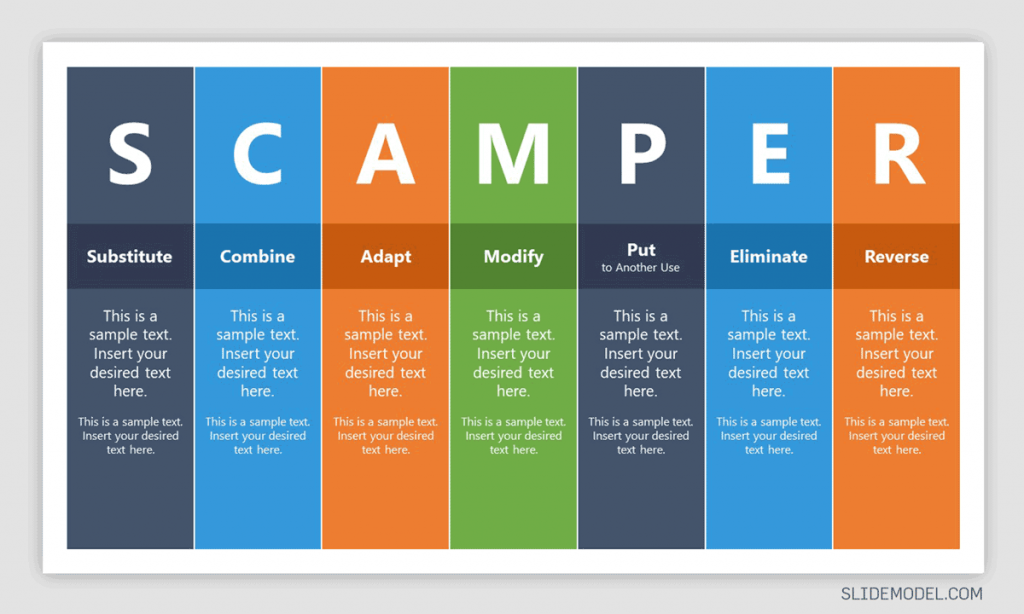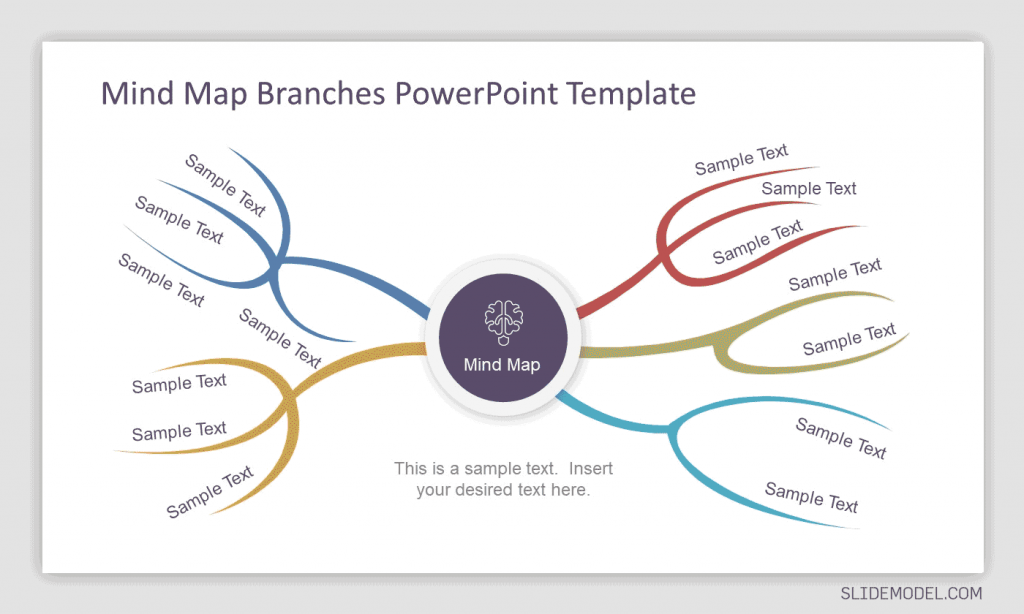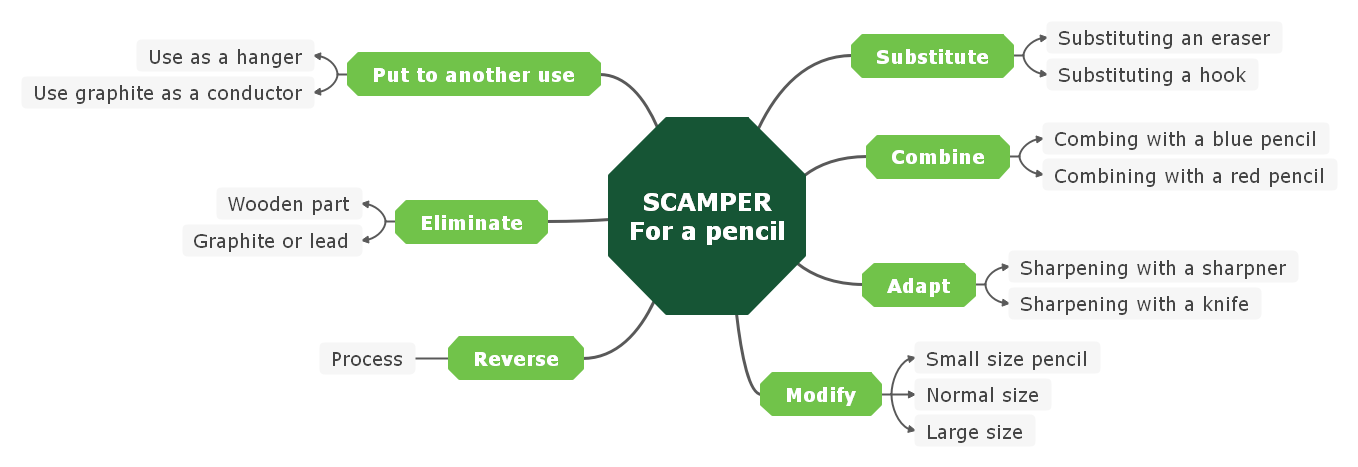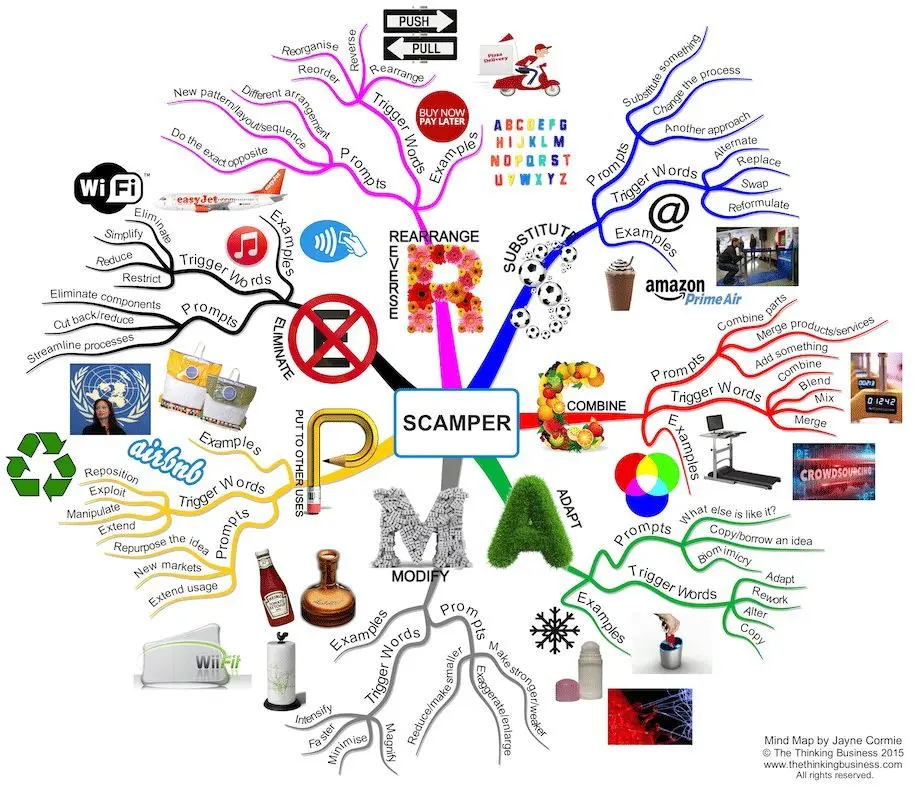Creativity and innovation are essential for success. Whether you’re developing a new product, solving a complex problem, or brainstorming ideas, having the right tools and techniques can make all the difference. In this comprehensive blog post, we’ll explore how to combine the power of SCAMPER with the versatility of mind maps to unlock your creative potential and generate innovative solutions.
SCAMPER is a creative thinking technique that helps individuals and teams generate new ideas and solutions by asking a series of targeted questions. The acronym stands for:
- Substitute: What components, materials, or people can you substitute to improve your product or process?
- Combine: How can you combine various elements to create something new or enhance existing ideas?
- Adapt: What ideas or features from other products, services, or industries can you adapt to your own situation?
- Modify: How can you change the size, color, shape, or other attributes to improve or alter your product or process?
- Put to another use: Can you repurpose your product or process for a different application or target audience?
- Eliminate: What features, steps, or components can you remove to simplify or streamline your product or process?
- Reverse: Can you rearrange the order of events or steps in your process to achieve better results?
 Image from: slidemodel
Image from: slidemodel
Benefits of Using SCAMPER
By applying SCAMPER’s method to a mind map, you can see your ideas unfold in a clear, organized way while exploring new angles and potential solutions. The mind map not only provides a visual representation of the ideas generated through SCAMPER’s questions but also helps you track the relationships between those ideas, ensuring you don’t miss any creative possibilities.
- Stimulates Creativity: SCAMPER encourages divergent thinking, prompting you to think outside the box and consider alternative perspectives. This leads to more innovative ideas and solutions that you might not have considered otherwise.
- Improves Problem-Solving: By breaking down problems into smaller, more manageable questions, SCAMPER makes it easier to find effective solutions. This structured approach helps you analyze the problem from multiple angles.
- Encourages Collaboration: SCAMPER can be used in group settings, fostering collaboration and diverse viewpoints. When team members contribute their ideas, the collective creativity can lead to breakthroughs that benefit the entire project.
- Enhances Adaptability: SCAMPER helps you adapt to changing circumstances by considering different approaches to a problem. This flexibility is crucial in dynamic environments where solutions must evolve rapidly.
- Provides a Structured Approach: The SCAMPER acronym offers a clear framework for generating ideas, making it easier to apply the technique consistently. This structure can help you stay focused during brainstorming sessions.
- Applicable to Various Domains: SCAMPER can be used in a wide range of contexts, from product development to business strategy and personal growth. Its versatility makes it a valuable tool for anyone looking to innovate.
- Encourages Critical Thinking: By challenging assumptions and prompting you to question the status quo, SCAMPER fosters critical thinking skills. This can lead to deeper insights and more effective decision-making.
- Facilitates Incremental Improvements: SCAMPER is not only about radical innovation; it can also help identify small changes that lead to significant improvements over time. This focus on incremental enhancements can be beneficial in continuous improvement processes.
Mind maps are visual diagrams that organize information around a central idea. They use a non-linear structure, with the main topic placed in the center and related ideas branching out in a radial pattern. Mind maps can be created using pen and paper or various digital tools, making them versatile and easy to use.
 Image from: slidemodel
Image from: slidemodel
How to Apply SCAMPER to Mind Maps: A Step-by-Step Guide
- Define Your Central Idea: Identify the problem or idea to explore and place it at the center of the map.
- Create Main Branches for SCAMPER: Draw seven branches representing each SCAMPER component.
- Add Sub-Branches: Add specific ideas or suggestions under each SCAMPER branch.
- Explore Possibilities: Use SCAMPER questions to guide brainstorming and note all ideas.
- Combine Ideas: Look for ways to merge ideas from different SCAMPER branches.
- Incorporate Visual Elements: Use colors, symbols, and images to enhance the mind map.
- Review and Refine: Regularly update and refine the map based on new insights.
- Evaluate and Implement: Assess and select the best ideas for implementation.
 Image from: slideteam.net
Image from: slideteam.net
Examples:Enhancing a Simple Pencil Using the SCAMPER Technique
 Image from: edrawmind
Image from: edrawmind
Let’s explore how we can improve a standard pencil by applying the SCAMPER technique. This method encourages creative thinking and innovation by prompting us to ask specific questions about the product. Here’s how we can enhance the pencil:
- Substitute: Instead of the traditional wooden top, we could replace it with an eraser, allowing users to quickly correct mistakes. Alternatively, we could add a small hook at the end of the pencil, enabling users to hang it conveniently when not in use.
- Combine: We can merge the concept of a pencil with multiple colors. By incorporating colored leads, users would be able to write in various colors without needing separate pencils. This feature would be particularly appealing for artists and students who enjoy colorful notes.
- Adapt: The pencil could be designed to adapt to different sharpening methods. For instance, it could feature a built-in sharpener at the end, allowing users to sharpen it on the go without needing additional tools.
- Modify: We could offer the pencil in various sizes to cater to different user preferences. For example, a shorter version could be designed for young children, a standard size for everyday use, and a larger version for artists who prefer a thicker grip.
- Put to Another Use: Beyond writing, the pencil could serve additional purposes. For example, it could be used as a clothes hanger for lightweight items, or the graphite could be utilized as a conductor in simple electronic projects, showcasing its versatility.
- Eliminate: We could eliminate the wooden casing entirely and encase the graphite in a durable plastic shell. This would not only extend the pencil’s lifespan but also allow for a more streamlined design. Alternatively, we could explore using a different, more cost-effective material for the lead that maintains quality while reducing production costs.
- Reverse: By reversing the traditional pencil design, we could create a pencil with a hollow center that allows users to store small items, such as a tiny eraser or a sharpener, within the pencil itself. This innovative approach could lead to new functionalities and enhance user convenience.
By applying the SCAMPER technique to a simple pencil, we can generate a variety of innovative ideas that enhance its functionality and appeal. This structured approach not only fosters creativity but also opens the door to potential new product developments.
Conclusion
Combining SCAMPER with mind maps is a powerful technique for unleashing your creativity and generating innovative ideas. By systematically applying the SCAMPER questions to a mind map, you can explore different perspectives, break free from traditional thinking patterns, and develop solutions that set you apart from the competition.
Whether you’re working on a new product, solving a complex problem, or brainstorming marketing strategies, applying SCAMPER to mind maps can help you unlock your creative potential and achieve your goals. So, grab a pen and paper (or your favorite mind mapping tool) and start exploring the endless possibilities that this powerful combination has to offer!



 Image from: slidemodel
Image from: slidemodel Image from: slidemodel
Image from: slidemodel Image from: slideteam.net
Image from: slideteam.net Image from: edrawmind
Image from: edrawmind
